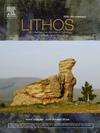Cretaceous thinning of the Kaapvaal craton and diamond resorption: Key insights from a highly-deformed and metasomatized ilmenite-dunite xenolith
IF 2.9
2区 地球科学
Q2 GEOCHEMISTRY & GEOPHYSICS
引用次数: 0
Abstract
Sheared peridotite xenoliths have been entrained by kimberlites in most global cratons but typically constitute only a minor proportion of mantle xenolith suites. Nevertheless, sheared peridotites are important because they record the short-lived cycles of metasomatism, deformation and rheological weakening that occur in Earth's ancient cratonic mantle immediately prior to their entrainment. Our work is focused on a highly-deformed ilmenite-dunite entrained from the south-east margin of the Kaapvaal craton by a Late Cretaceous kimberlite from Thaba Putsoa (northern Lesotho). The compositions of olivines and ilmenites show that this dunite is enriched in Fe and Ti and not simply a fragment of highly-refractory mantle. Two populations of olivine porphyroclasts are present: (i) Olivine porphyroclasts with moderate forsterite (Fo) contents (Fo85–86) and minor and trace element concentrations comparable to those in many other sheared peridotites and also Cr- and Fe-poor olivine megacrysts (Fo83–88) found in kimberlites from northern Lesotho and adjacent South Africa; and (ii) olivine porphyroclasts (Fo78–79) with compositions that are enriched in Mn, Zn and Ge and depleted in Ni, Ca, Cr, Al, V and Cu, and overlap with Cr-poor, Fe-rich olivine megacrysts (Fo78–82). Olivine neoblasts in the sheared ilmenite-dunite xenolith reveal the full range of Fo contents (Fo79–86) exhibited by the porphyroclasts whereas the orthopyroxene neoblasts have Mg# of 86.5, CaO contents of ∼1 wt% CaO and variable Ti, Al and Cr contents. Ilmenite neoblasts have variable concentrations of TiO2 (45–55 wt%), MgO (9–12 wt%), and calculated Fe2O3 (2–12 wt%).
This sheared fragment of mantle material is relatively unique in that it experienced multiple oxidizing magmatic/metasomatic events accompanied by deformation, giving important insights into a highly-dynamic environment within the Kaapvaal craton 90 Ma ago. The olivine megacrysts are thought to have crystallized in the Kaapvaal mantle from percolating proto-kimberlite melts and their chemical similarities with the porphyroclasts in the ilmenite-dunite imply that they both crystallized from a similar melt, but the two populations of porphyroclasts were subsequently mechanically mixed during deformation and contemporaneous oxidizing, Ti-rich metasomatism. Oxidation is implied by heterogeneous V/Sc ratios in olivine porphyroclasts and neoblasts and heterogeneous Fe2O3 contents in ilmenite neoblasts. We propose that multiple proto-kimberlitic pulses were widespread in northern Lesotho during the Late Cretaceous and led to the crystallization of megacrysts, metasomatism, oxidation and deformation of the surrounding mantle wall-rock. This short-lived metasomatism-deformation cycle caused mechanical, thermal and chemical perturbations in the lower Kaapvaal lithosphere, which had several consequences: (i) chemical and physical pre-conditioning of the lithosphere that facilitated subsequent kimberlite pulses to reach the surface; (ii) an overall mechanical weakening and destabilization of the lower lithosphere; and (iii) resorption of any diamonds present due to interaction with oxidizing melts.
Kaapvaal克拉通的白垩纪减薄与钻石吸收:来自高度变形和交代的钛-泥质捕虏体的重要见解
剪切橄榄岩捕虏体在全球大多数克拉通中都是由金伯利岩夹带的,但通常只占地幔捕虏体套件的一小部分。然而,剪切橄榄岩是重要的,因为它们记录了在它们被夹带之前发生在地球古代克拉通地幔中的短暂的交代、变形和流变减弱循环。我们的工作集中在Kaapvaal克拉通东南边缘被Thaba Putsoa(莱索托北部)晚白垩世金伯利岩带走的高度变形的钛铁矿-暗质岩。橄榄石和钛铁矿的组成表明,该白云石富含铁和钛,而不是单纯的高难熔地幔碎片。存在两类橄榄石卟啉碎屑:(i)橄榄石卟啉碎屑具有中等的橄榄石(Fo)含量(Fo85-86)和微量元素浓度,与许多其他剪切橄榄岩中的含量相当,也与莱索托北部和邻近南非的金伯利岩中发现的贫铬和贫铁橄榄石巨晶(Fo83-88)相当;(ii)富锰、锌、锗,贫镍、钙、铬、铝、钒、铜的橄榄石卟啉碎屑(fo78 ~ 79),与贫铬、富铁的橄榄石巨晶(fo78 ~ 82)重叠。剪切钛-褐岩捕虏体中的橄榄石新母细胞显示了斑岩碎屑所显示的全部Fo含量(Fo79-86),而正辉石新母细胞的Mg#为86.5,CaO含量为~ 1 wt% CaO, Ti、Al和Cr含量可变。钛铁矿新母细胞含有不同浓度的TiO2 (45-55 wt%)、MgO (9-12 wt%)和Fe2O3 (2-12 wt%)。这个剪切的地幔物质片段相对独特,因为它经历了多次氧化岩浆/交代事件并伴随着变形,为了解90 Ma前Kaapvaal克拉通的高动态环境提供了重要的见解。橄榄石巨晶被认为是在Kaapvaal地幔中由渗透的原始金伯利岩熔体结晶的,它们与钛铁矿-白云岩中的斑岩碎屑的化学相似性暗示它们都是由类似的熔体结晶的,但这两类斑岩碎屑随后在变形和同时期的氧化、富钛交代作用中机械混合。橄榄石卟绿碎屑和新母细胞中V/Sc的不均匀比例以及钛铁矿新母细胞中Fe2O3的不均匀含量暗示了氧化作用。我们认为,晚白垩世莱索托北部广泛存在多个原金伯利岩脉冲,这些脉冲导致了周围地幔围岩的巨晶结晶、交代、氧化和变形。这种短暂的交代-变形循环引起了下Kaapvaal岩石圈的机械、热和化学扰动,产生了以下几个后果:(i)岩石圈的化学和物理预处理促进了随后的金伯利岩脉冲到达地表;(ii)下岩石圈的整体机械弱化和不稳定;(三)由于与氧化性熔体相互作用而导致的任何金刚石的再吸收。
本文章由计算机程序翻译,如有差异,请以英文原文为准。
求助全文
约1分钟内获得全文
求助全文
来源期刊

Lithos
地学-地球化学与地球物理
CiteScore
6.80
自引率
11.40%
发文量
286
审稿时长
3.5 months
期刊介绍:
Lithos publishes original research papers on the petrology, geochemistry and petrogenesis of igneous and metamorphic rocks. Papers on mineralogy/mineral physics related to petrology and petrogenetic problems are also welcomed.
 求助内容:
求助内容: 应助结果提醒方式:
应助结果提醒方式:


